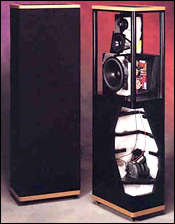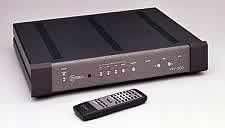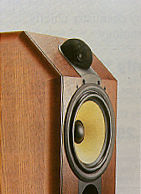LATEST ADDITIONS
Recording of August 1996: Earth Stories
<B>CYRUS CHESTNUT: <I>Earth Stories</I></B><BR> Cyrus Chestnut, piano; Steve Kirby, bass; Alvester Garnett, drums (on "Cooldaddy's Perspective," add: Eddie Allen, trumpet; Steven Carrington, tenor sax; Antonio Hart, alto sax)<BR> Atlantic Jazz 82876-2 (CD only). Yves Beauvais, Cyrus Chestnut, prods.; Joe Ferla, eng. AAD. TT: 48:54
Vandersteen Cinema loudspeaker system (SGHT Review)
The Vandersteen 3A is a higher-end variation on the theme established by the company's first loudspeaker, the 2C. The latter is still available, though much updated into the current, highly popular 2Ce. A four-way design, the 3A has separate sub-enclosures for each drive unit; the whole affair is covered with a knit grille-cloth "sock" with wood trim end pieces. A rear-mounted metal brace allows the user to vary the tiltback—an important consideration for best performance with this loudspeaker.
Genesis Technologies Digital Lens
Let's say you play a CD on a poor-quality CD transport and store the digital audio data in a massive computer memory. You then repeat the process, but this time play the CD into the memory from the finest CD transport extant (say, the Mark Levinson No.31). A week later you feed the two sets of data from the massive memory into a digital processor and listen to the music. Would the CD transports' sonic signatures be removed from the signal? Could you hear a difference between the transports a week later?
Recording of July 1996: Danzas Medievales Españolas
<B>EDUARDO PANIAGUA GROUP: <I>Danzas Medievales Españolas</I></B><BR> Eudardo Paniagua, flautas de bisel, nay, fujara, psalterio, tromba marina, darbuga, tar, címbalos, caraqueb, cascabeles; Cesar Carazo, canto, viola de brazo; Wafir Sheik, laúd árabe, darbuga, pandero, sonajero; Jaime Muñoz, axabeba, kaval, chalumeau, dulcimer, sonajas; Enrique Almendros, flautas de tres agujeros, gaitas, gaita charra y tamboril, tar, címbaols, campanas; Luis Delgado, zanfona, laúd, dutar, vihuela de péñola, santur, fujara, cántara, darbuga, zarb, bendir, pandera, tambor, tar<BR> M•A M034A (CD only). Todd Garfinkle, prod., eng. DDD. TT: 72:05
Krell KAV-300i integrated amplifier
Is Krell risking its reputation? With the KAV-300i, an integrated amplifier that was originally envisaged as an export model, but for which home demand is clearly increasing, the Connecticut-based amplifier manufacturer is dabbling in low-cost territory. Previous Krell amplifiers have been known for their prodigious drive capability. Time and time again, it is found that the true measure of the bass performance of a big speaker isn't realized until a Krell power amplifier is brought into service. But how could an amplifier with a meaty 150Wpc specification and full remote control be built to sell for just $2350.
Recording of June 1996: New Moon Daughter
<B>CASSANDRA WILSON: <I>New Moon Daughter</I></B><BR> Cassandra Wilson, vocals; Brandon Ross, guitars; Kevin Breit, guitars, banjo, Irish bazouki; Charlie Burnham, violin; Lonnie Plaxico, bass; Dougie Bowne, drums; others.<BR> Blue Note CDP 8 32861 2 (CD only). Craig Street, prod.; Danny Kopelson, eng. TT: 61:59
B&W Compact Domestic Monitor 1 loudspeaker
While large, floorstanding speakers appear to offer the most material for the buck, I feel that small stand-mounted speakers both offer the best value in sound quality, as well as standing the best chance of sounding good in moderate-sized listening rooms. In recent months <I>Stereophile</I> has reviewed a varied group of such speakers. In order of descending price, these include the Acoustic Energy AE2 Signature ($5495/pair, November '95); Dzurko Acoustics Jaguar ($4500/pair, reviewed elsewhere in this issue); <A HREF="http://www.stereophile.com//loudspeakerreviews/462/">Totem Mani-2</A> ($3995/pair, February '96); Platinum Audio Solo ($2498/pair, November '95); Coincident Speaker Technology Troubador ($1495/pair, January and February '96); <A HREF="http://www.stereophile.com//loudspeakerreviews/615/">Joseph Audio RM7si</A> ($1299-$1499/pair, February '96); <A HREF="http://www.stereophile.com//loudspeakerreviews/445/">Acarian Alón Petite</A> ($995-$1195/pair, January '96); Phase Technology PC80 II ($699/pair, December '95); and Spectrum 108cd ($399/pair, December '95).
PSB New Stratus Mini
While large, floorstanding speakers appear to offer the most material for the buck, I feel that small stand-mounted speakers both offer the best value in sound quality, as well as standing the best chance of sounding good in moderate-sized listening rooms. In recent months <I>Stereophile</I> has reviewed a varied group of such speakers. In order of descending price, these include the Acoustic Energy AE2 Signature ($5495/pair, November '95); Dzurko Acoustics Jaguar ($4500/pair, reviewed elsewhere in this issue); <A HREF="http://www.stereophile.com//loudspeakerreviews/462/">Totem Mani-2</A> ($3995/pair, February '96); Platinum Audio Solo ($2498/pair, November '95); Coincident Speaker Technology Troubador ($1495/pair, January and February '96); <A HREF="http://www.stereophile.com//loudspeakerreviews/615/">Joseph Audio RM7si</A> ($1299-$1499/pair, February '96); <A HREF="http://www.stereophile.com//loudspeakerreviews/445/">Acarian Alón Petite</A> ($995-$1195/pair, January '96); Phase Technology PC80 II ($699/pair, December '95); and Spectrum 108cd ($399/pair, December '95).








